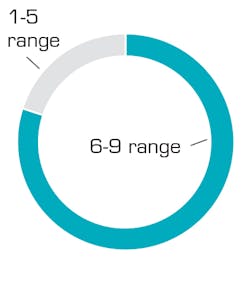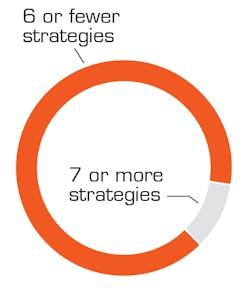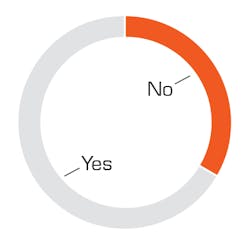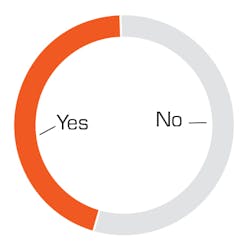Inside the Numbers: Latest Research Report Findings from the Levin Group Data Center
by Roger P. Levin, DDS
The practice of dentistry continues to evolve. In our latest round of research, we've seen new trends in team-building and internal marketing. Here are some of the key stats and what we think they mean for the future of dentistry.
PART 1: The latest data on effective team building Surprising results from An online survey on team building
Levin Group recommends that dentists spend 98% of their time on direct patient care. Dentists should leave to the team almost all of the administrative duties, and they should allow hygienists and assistants to handle all clinical activities appropriate to them. In this model, a strong, well-trained team is a necessity.
How strong are the teams we surveyed? Here are the results:
HOW DENTISTS PERCEIVE THEIR TEAMS
On a scale of 1 to 10, with 10 being the most favorable,
80% of responding dentists scored their teams in the 6 to 9 range
Responding dentists viewed their staff members favorably. Only 3% of respondents ranked their team a perfect 10, while no dentist gave their staff a 1. Seventeen percent of dentists ranked their teams in the 2 to 5 range. Seven was the most popular ranking at 23%
For team morale, 74% of dentists rank their team in the 6 to 9 range
The most popular ranking was again 7, with 21% of respondents rating employee morale at that high level. Nearly a quarter of dentists (22%) ranked employee morale in the 1 to 5 range, an obvious sign that the dentist as the practice leader must do more to change the environment in the office.
Do you hold a short business meeting every morning?
Yes: 63%
No: 37%
Only 63% of dental practices surveyed regularly hold a morning meeting. This is troubling for several reasons. The morning meeting, or what I prefer to call the Daily Business Meeting, should be the standard way for dental practices to start the day. The meeting should be brief (10 to 15 minutes), highly focused on that day's events (scheduled patients, treatment planned, gaps in the schedule, etc.), and be a forum for addressing recurring minor issues (for example, the phone not being answered in three rings or less). The morning meeting sets the tone for the day. It should be informative, motivational, and positive. It should provide a framework of what to expect for the day. When it is done consistently and done well, it helps turn a group of individuals into a team.
48%
of practices provide only one to five hours of annual training
Since the onset of the Great Recession six years ago, dentistry has undergone a period of profound change. During such times, training becomes even more important. Just as dentists need to fulfill CE requirements each year, dental teams need a variety of training to maintain and improve their performances. In this era of accelerated change, about half of dentists aren't even providing their teams a full day of training. With 75% of practices suffering production declines during the last five years, dental teams need more training - not less - to help their practices grow.
More than one third of responding dentists (36%) recognize the need for training in the new dental economy, providing 11 or more hours annually. Sixteen percent fall somewhere in between, offering six to 10 hours of training.
71%
of responding dentists said they hold a quarterly staff meeting to deal with large issues
The best practices conduct both daily and quarterly meetings. By holding a daily business meeting, dentists and teams can fix minor problems before they become major issues.
59%
of practices conduct an annual performance review for team members
This is another surprising statistic. Annual performance reviews provide employees essential feedback on what they're doing right and where they can improve.
Regular communication between dentists and their teams is critical to practice success. When gaps in communication occur, it usually indicates a problem regarding systems, management, or leadership.
Annual reviews enable dentists and team members to devise an appropriate training regimen to help employees maintain performance, as well as develop new skills.
CONCLUSION
An effective team is the cornerstone of a successful practice. By giving team members the right tools, such as training, meetings, and performance reviews, dentists put their practices in the best position to be successful. I encourage all dentists to look at their practices to see if they are doing everything they can to build a better, more effective team.
PART 2 The latest data on internal marketing Survey conducted 2014
In the new, post-recession dental economy, many dentists realize that their practices will not grow significantly without effective and consistent marketing. For the majority of general practices, Levin Group recommends concentrating exclusively on internal marketing - which is far more cost-effective than external marketing.
How well are dentists marketing their practices? Here are the results:
Do you and your team ask all patients for referrals?
Yes: 27%
No: 73%
The single most powerful internal marketing strategy is also the easiest and least expensive to implement. It consists of asking patients for referrals. This works extremely well for two important reasons.
First, the current patient base is a "captive audience" - individuals have a relationship with the practice and spend time there not only undergoing exams and treatment, but also interacting with the doctor and staff. Asking for referrals can fit naturally into these interactions.
Second, most people like to make and receive recommendations from friends, family members, and other people they know. When someone needs a dentist, a suggestion from an acquaintance will carry more weight than an ad or listing.
Considering the simplicity of this strategy, you might think that a majority of dentists rely on it. However, we see that three out of every four respondents do not ask for referrals.
Almost 90%
of practices use 6 strategies
or fewer for internal marketing
Another survey question was, "How many structured marketing strategies are you currently using?" Unfortunately (though not surprisingly), more than half of the dentists answered one to three strategies, and almost 90% are using six strategies or fewer. Levin Group has substantiated the fact that practices with at least 15 strategies in their marketing program achieve much better results. Only 2.2% of survey respondents said they were using 13 to 15 strategies.
Almost 1/3
of respondents do not ask their patients for customer service feedback
Excellent customer service lays the foundation for effective internal marketing. Patients may not be able to judge the finer points of clinical performance, but they are the undisputed experts on the subject of customer service.
For this reason, our survey posed the question, "How do patients rate the customer service provided by the practice?" Most answers clustered at the high end of the 1 to 10 scale, with 27% at 10, 20% at 9, and so on. The highest score - 31% - came from practices that said they "do not survey patients on customer service." In other words, almost one third of practices surveyed can only guess at how well they are doing in this critically important area.
45%
of practices sponsor community activities
Strictly speaking, practice engagement in the local community is not "internal." Yet, like typical internal marketing strategies, it is relatively inexpensive and takes advantage of word-of-mouth advertising. By showing support for community groups and activities, dental practices increase awareness and strengthen their image among the local population from which new patients will inevitably come. It's smart, yet more than half of the practices surveyed - 55% - do not sponsor community activities.
27.5%
of practices do not use social media
Survey results suggest that practices recognize the value of social media and have established an online presence. Facebook is by far the social media preference. All respondents who used social media specified Facebook. Less than one third as many mentioned Twitter, while other media barely showed up. A substantial number of practices (27.5%) are still social media holdouts.
82.5%
of practices do not reward their top referrers
The final question in this survey was, "Do you have a program to recognize patients who are your top referrers?" The majority of respondents - 82.5% - indicated that they do not. Those that do usually express their thanks with gift cards, other rewards, and personal thank-you messages. As more practices learn the basics of internal marketing - such as asking for referrals, using multiple strategies, and surveying patient satisfaction - we would expect offices to recognize that acknowledging top referrers will encourage them, and others, to refer even more new patients.
CONCLUSION
Levin Group has long been a proponent of internal marketing. Even before the Great Recession, we guided our consulting clients in how to use it effectively, to the point of recommending they add a part-time internal marketing coordinator to their practice team. Now, as more practices seek ways to increase production in spite of the more challenging economy, the word about internal marketing seems to be spreading, slowly but surely.
To learn how to use internal marketing to build a more productive practice, come to an upcoming seminar by Dr. Levin. Pick the date and location that best fit your schedule at www.levingroup.com/gpseminars.












